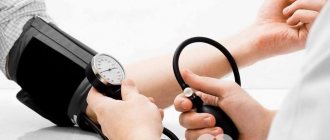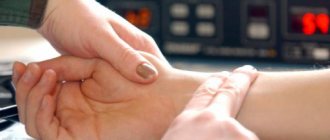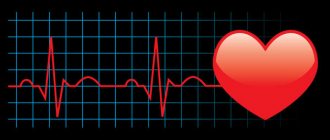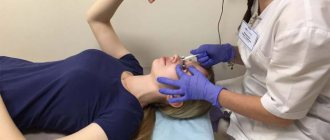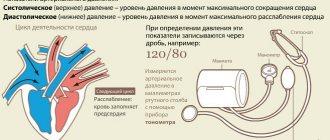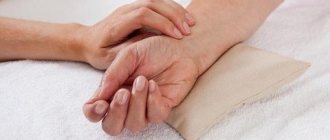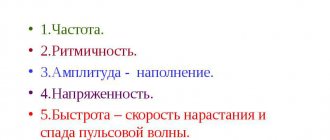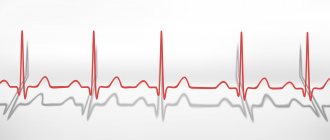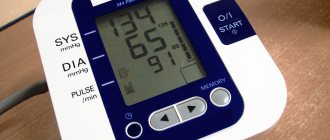Why take your pulse?
Periodically in everyday life
Be sure to check the pulse if a person feels unwell.
With this simple manipulation you can determine the presence of cardiovascular diseases. In the old days, it was enough for a healer to measure the pulse to make a diagnosis. Now there are accurate diagnostic methods, but they have not stopped measuring heart rate. If a person constantly engages in sports, he develops bradycardia (decreased heart rate). When the heart rate slows, patients experience malaise, drowsiness, and headaches. You must inform your doctor about this.
Enter your pressure
Move the sliders
If a person leads a passive lifestyle or is obese, he may develop tachycardia (increased heart rate). In this case, the patient experiences headache and heart pain, suffocation, and fear of death. If the heart rate rises above 150 beats per minute, you should urgently call an ambulance. You can take a sedative before her arrival.
By measuring your pulse, you can check whether diseases of the nervous system are progressing. If a woman is pregnant, then the condition of the child can be determined (he suffers if the woman has problems with heartbeat). Elderly people often suffer from changes in blood pressure and pulse. It can cause heart attack, myocardial infarction and stroke
To avoid this or stop an attack before consequences appear, it is important to measure the pulse and take measures at the slightest deviation (drink a pill, ventilate the room, wash with cold water).
During training
During training, be sure to measure your pulse. If your heart beats too intensely, you should stop the activity. This is especially true for older people or those with chronic diseases, otherwise an attack or crisis may occur. To avoid this, you need to inform the trainer about your health problems so that he can select the appropriate complex.
If everything is normal with your health, you still need to measure your pulse. Fat is burned best when your heart rate is in the fitness zone. It is different for everyone, and a coach can calculate it. If the heart is not trained, then it is important that the pulse does not exceed the maximum threshold. It can be calculated using the formula: 200 minus age. There are several zones. They can be studied in the table:
| Zone | Load level | |
| Aerobic | 50-60% of maximum | A person in this zone warms up his muscles by warming up, doing simple exercises or running slowly. The heart rate increases, but evenly. The duration of the load is 20 minutes. |
| Fitness (fat burning) | 60-75% of maximum | Simple exercises are performed, but the load gradually increases. Fat begins to burn slowly. The duration of the load is 40 minutes. |
| Fitness (endurance) | 75-85% of maximum | The intensity of the load increases and the body begins to burn carbohydrates. Duration: 10 minutes. |
| Improvement (hard) | 85-90% of maximum | The heaviest loads, fat is burned quickly. The person is sweating, the heartbeat is accelerated. Don't go overboard. Duration: 2-10 minutes. |
| Improvements (maximum) | 90-100% of maximum | Suitable for professional athletes only. The body works at full capacity. Duration: 2 minutes. |
What is pulse
This term refers to the frequency of contraction of the heart muscle. It allows you to evaluate the vibrations of arterial walls over a certain period of time.
This parameter is affected by the following:
- age category - infants are characterized by a more frequent heartbeat;
- gender – women have a more frequent pulse;
- emotional state - severe stress and anxiety can lead to increased heart rate;
- increase in body temperature.
Another important parameter is rhythm. This indicator shows the interval of passage of pulse waves following each other. The pulse can be rhythmic or arrhythmic.
Also, when determining the pulse, its filling is important. According to this criterion, the following types of pulse are distinguished: . vaguely defined; barely perceptible; medium filling; filled too much.
- vaguely defined;
- barely perceptible;
- medium filling;
- filled too much.
In addition to the above criteria, there are other parameters:
- Tension is the force required to completely compress the artery. This setting comes in soft, medium and hard.
- Height - represents the fluctuation of the walls of the arteries. It is determined by summing the filling and voltage indicators. The height is small, medium and large.
- Shape or speed - indicates a change in the volume of the artery. A rapid pulse is characteristic of fever and anemia. Slow indicates the appearance of stenosis. A double pulse indicates a deteriorating tone of the peripheral artery. At the same time, the contractile capabilities of the myocardium remain within normal limits.
Please note: Women's heart rate is 5-10 points higher than men's. The average rate in healthy people is 60-80 beats per minute
Moreover, the parameter also differs by age category. In newborns, the rate is twice as high as in parents.
As you get older, your heart rate decreases due to the development of your cardiovascular system. As the heart grows and its strength increases, fewer contractions are required for normal blood circulation. Athletes tend to pulsate at a slower rate because their body is accustomed to the stress.
The main feature of the pulse is its instability. Many factors influence the change in this parameter:
- Emotionality. The stronger the emotions a person experiences, the faster the heart beats.
- Health status. An increase in temperature of just 1 degree leads to an increase in heart rate by 10 beats.
- Consumption of certain foods. Alcoholic drinks, coffee, energy drinks, and too hot food can cause increased heart rate.
- Physiological position. The slowest pulse is observed in a horizontal position. The maximum parameter is achieved when a person is standing.
- Times of Day. From 8 to 12 am the heartbeat reaches its maximum values. At night it slows down significantly. Pulsation also increases during training. In such a situation, it is important to control this indicator. To calculate the maximum allowable heart rate during cardio training, subtract your age from 220.
How to measure your pulse correctly
It is customary to measure it within a minute, although the result can be recorded after 15 seconds and increased by 4 times. In order to find and measure it, the wrist is grasped with the index, middle and ring fingers. It is better for representatives of the stronger sex to measure on the left hand, and for the fair sex - on the right.
When your fingers feel the pulsation, you can start measuring. To maintain control, all received data is recorded.
Correct measurement of pulse on the hand
The radial artery is known to be located in a person's wrist, so close that it can be seen. That is why every person can take measurements in this exact place.
To do this you need to do the following:
- The hand is turned palm up.
- The hand is held at chest height without support. Only a completely horizontal surface is allowed.
- On the second hand, two fingers (index and middle) are brought together and placed on the prepared wrist, slightly below the thumb.
- Feel and find the artery. To the touch it looks like a dense thin tube.
- Apply a little pressure until you can feel the shock.
- Count the number of these shocks.
It is important to remember that in no case should you feel it with not one, but two fingers. Moreover, the thumb is not at all suitable for this due to its strong pulsation.
. Correct measurement of pulse on the carotid artery
Correct measurement of pulse on the carotid artery
Measuring the pulse at the wrist is not always possible, because, for example, in cases of loss of consciousness, the radial artery may not be palpable. We have to resort to measurement on the carotid artery.
To do this, you just need to do a few steps:
- The person should sit or lie on their back. Do not stand under any circumstances.
- A pair of fingers (index and middle) should be drawn along the neck from the top to the bottom. In this way, the most pulsating place is found. Most often this turns out to be a hole in the neck.
- Fingers should not be strained, pressed or placed on two arteries at once. These actions may cause you to faint.
- Count the number of beats.
How to measure on the carotid artery?
The carotid artery is one of the large vessels that supplies blood to the brain. Therefore, even with insignificant heart rate indicators, it will be easy to feel the vibrations of the walls on the carotid artery and measure the pulsation. On the carotid artery vessel, the pulse measurement technique is effective due to:
- size;
- pairings;
- availability of a place for examination.
Finding the carotid arteries is easy as follows:
- Place two fingers of your right hand tightly together: index and middle.
- Place your fingers on the thyroid cartilage (Adam's apple).
- Slide to the side until it reaches the indentation on the neck.
- Feel the point of the most obvious pulsation of the vessel.
To measure the pulse in this place yourself, you need to:
- Sit on a chair and lean back.
- Prepare a stopwatch, a watch with a second hand, you can also use the functions of your mobile device.
- With the relaxed fingertips of your right hand (for left-handed people, the left hand), folded together, feel the pulsation of the carotid artery.
- Record the time and count out loud the pulses of blood against the walls of the artery.
Heart rates less than 60 beats per minute and more than 100 beats per minute require medical attention.
Heart rate can be measured on both paired arteries: right and left, but this should not be done simultaneously. Do not press too hard on the vessel, so as not to stop the blood flow, causing dizziness or loss of consciousness.
Pulse measurement locations
Basic properties of pulse
Frequency
- the number of pulse fluctuations in 1 minute. At rest, a healthy person has a pulse of 60-80 per minute.
When the heart rate increases (tachycardia),
the number of pulse waves increases (tachyphygmia), and when the heart rate slows
(bradycardia),
the pulse is rare (bradysphygmia).
Rhythm
— determined by the intervals between pulse waves.
If pulse fluctuations occur at regular intervals, therefore, the pulse is rhythmic.
When the rhythm is disturbed, an incorrect alternation of pulse waves is observed -
an irregular
pulse. In a healthy person, the contraction of the heart and the pulse wave follow each other at regular intervals.
Voltage
— determined by the force with which the researcher must press the radial artery so that its pulse fluctuations completely stop.
Pulse voltage depends on blood pressure. With normal blood pressure, the artery is compressed with moderate force, so the normal pulse is moderate.
With high blood pressure, it is more difficult to compress the artery - such a pulse is called
tense,
or
hard.
In case of low pressure, the artery contracts easily - the pulse
is soft.
- The pulse rate is graphically marked in red on the temperature sheet.
- Pulse examination sites are pressure points during arterial bleeding.
- In the carotid arteries, the pulse is examined without strong pressure on the artery, since a sharp slowdown in cardiac activity is possible, up to cardiac arrest and a drop in blood pressure, dizziness, fainting, and convulsions may occur.
• Pulse deficiency - the difference between heart rate and pulse rate (normally there is no difference).
Algorithm for determining the pulse on the radial artery.
1. Use the fingers of your right hand to grasp the patient’s hand in the area of the wrist joint.
2. Place your first finger on the back of your forearm.
3. With fingers II-IV, feel the pulsating radial artery and press it against the radial artery.
4. Determine the characteristics of pulse waves for 1 minute.
5. It is necessary to determine the pulse simultaneously in the right and left radial arteries, comparing their characteristics, which normally should be the same.
6. Data obtained from examining the pulse on the radial artery are recorded in the medical history or outpatient card, and noted daily with a red pencil on the temperature sheet. Column “P” (pulse) shows heart rate values from 50 to 160 per minute.
For diagnostic purposes, you can determine the pulse in other arteries:
ON THE CAROTID ARTERY - with low blood pressure, most often the pulse on the radial artery is very difficult to detect, so the pulse on the carotid artery is counted. The pulse should be examined alternately on each side without putting strong pressure on the artery. With significant pressure on the arterial wall, the following are possible: a sharp slowdown in cardiac activity, up to cardiac arrest; fainting; dizziness; convulsions. The pulse is palpated on the lateral surface of the neck anterior to the sternocleidomastoid muscle between the upper and middle third.
ON THE FEMORAL ARTERY - the pulse is examined in the groin area with the thigh straightened with a slight outward rotation.
ON THE POPULAR ARTERY - the pulse is examined in the popliteal fossa with the patient lying on his stomach.
ON THE POSTERIOR TIBIAL ARTERY - the pulse is examined behind the inner malleolus, pressing the artery against it.
ON THE ARTERY OF THE DORSAL FOOT - the pulse is examined on the dorsum of the foot in the proximal part of the first intermetatarsal space.
How to determine on the radial artery yourself?
Despite the availability of the method, not everyone knows how to count the pulse on the hand correctly. Knowing how to measure the pulse by palpating the radial artery, which is located on the wrist, you can obtain objective information about the state of your health. The radial artery is released through the skin so that its pulsation is noticeable even to a non-specialist.
To understand how to measure the pulse on your hand yourself, you should find this place:
- Sit on a chair.
- Relax your left hand.
- Place your hand palm up.
- Place the 2nd, 3rd, 4th fingers of your right hand on the inside of your wrist.
- Press the radial artery and feel the pulsation.
- Using the algorithm for measuring the pulse on the radial artery, calculate the number of pulse oscillations:
- put a stopwatch in front of you;
- Count your heart rate for 1 minute.
The heart rate of a healthy person should normally be from 60 to 80 beats per minute.
On the right or left hand?
Having understood how to calculate the pulse manually, you need to decide on which hand it is preferable to measure it.
You can measure it on your hands: right and left, normally the measurement result should be the same. But practice shows that more correct results are obtained on the left hand, located closer to the heart.
Knowing how to take your pulse on your arm can help save your life.
Algorithm of actions
The algorithm of actions when measuring pulse is not complicated, but for the reliability of the results, it requires precision execution. A step-by-step execution of the algorithm will allow you to understand how to correctly measure the pulse on your hand:
- Prepare a stopwatch and place it in a position convenient for monitoring.
- Remove items of clothing, wristwatches and rings that constrict and prevent access to blood vessels, so that nothing impedes blood circulation.
- Sit comfortably, leaning back in a chair, or take a horizontal position.
- Turn the palm of your left hand up.
- It is acceptable to lightly press your hand to your chest.
- Using three fingers of your right hand: index, middle and ring, simultaneously press on the artery.
- Feel for clear pulses of blood inside the vessel.
- Start the stopwatch and count the contraction frequency for 60 seconds.
- Measure the pulse on your right hand in a similar way.
- Record the result.
Systematic measurement of pulse should be carried out under the same conditions: in the same position, at the same time of day, for a certain amount of time.
Method of counting in 10 seconds
Speaking about how to calculate the pulse in 10 seconds, it must be said that this technique is used by athletes during active sports.
Using a heart rate count of 10 seconds multiplied by 6 allows them to quickly measure the number of heart beats per minute and determine physical activity.
It is not recommended to use this technique in all other cases, since this calculation has a very high error - up to 18 beats per minute! This is explained by the fact that a person cannot correctly take into account the first and last heart sounds in an exact 10-second period.
More accurate data can be obtained by recording the time spent on 10 pulsations. How to calculate the pulse per minute when measuring 10 beats:
- Feel for clear vibrations of the artery walls in a convenient place.
- Start the stopwatch.
- Count the vibrations of the artery from the second beat.
- Stop counting after 10 heartbeats.
- Record the time.
The counting method is as follows: 10 beats x (60 seconds / fixed time). For example, if 4 seconds have passed in 10 beats, then the pulse at the moment will be equal to 150 beats per second = 10 x (60 / 4).
Knowledge of how to measure your pulse in 10 seconds can be important in a force majeure situation.
How to correctly measure the pulse on your hand
We measure the pulse on the hand correctly!
To detect heart rhythm disturbances, it is necessary to measure the pulse correctly. Firstly, it is best to do this in a state of calm, only then the indicators will be as accurate as possible
It is important to remember that the pulse rate, that is, heartbeats, is influenced by many external factors and during the day it can change its indicators.
To identify pathologies, it is better to measure your pulse at rest 2-3 times a day for a week. By recording the results, you can trace the dynamics and draw conclusions - whether there is a heart rhythm disturbance or not.
It is best to measure the pulse on your hand, and as already mentioned, in a state of calm. You need to place the middle and index fingers of your left hand on your right wrist and feel for the pulse. When the pulsation can be heard best, you need to count the number of beats in 20 seconds. Then multiply the resulting figure by three to determine your heart rate per minute.
If you suspect a heartbeat disorder, it is better not to be lazy and measure your pulse for the entire minute.
This is due to the fact that the heartbeat may become erratic, and in 10-20 minutes you may not understand this. In case of heart contraction disturbances, you should consult a specialist for help. The doctor will prescribe a full examination, make a diagnosis and determine treatment methods.
Normal pulse rate and reasons for deviation from the norm
Deviation of heart rate from the norm is an alarming sign!
There are fixed indicators that determine the normal number of heartbeats in people of different ages.
These figures are from the National Institute:
- in newborns - up to 140 beats per minute
- in children under one year of age – up to 130 beats per minute
- up to two years – 90-100 beats/min.
- up to seven years – 85-95 beats/min.
- up to 14 years – 70-90 beats per minute
- up to 30 years - 60-70 beats per minute
- up to 50 years old - 60-85 beats per minute; over 50 years old up to 95 beats per minute
But in addition to such established standards, there is also an acceptable standard: for athletes who train for a long time, the heart rate can be 40-60 beats per minute. If such an indicator is observed for a long time and the person does not feel unwell, dizziness, anemia and other symptoms, then this indicator is considered normal for this person and he is completely healthy.
If the pulse rate is below normal, this indicates some disturbances in the cardiovascular system.
If a child’s pulse is above 140 beats per minute, and an adult’s is above 70 beats in a state of calm, this indicates increased work of the heart. That is, the heart contracts more often than it should. In medicine, this pathology is called tachycardia. There are many reasons for its occurrence. The first factor is a lack of oxygen, which occurs due to anemia or problems with the respiratory system.
As a rule, increased heart rate is closely related to increased blood pressure. Since tachycardia and hypertension can lead to other diseases, it is necessary to be treated promptly.
You can learn more about bradycardia from the video:
Normal heart rate at rest and during exercise.
Normally, the heart rate of an adult at rest is 50-85 beats per minute. Under load, when playing sports, the heart rate can increase significantly. People with diseases of the cardiovascular system are recommended to regularly measure their pulse during physical activity. It is not recommended that it exceed 85% of your maximum heart rate. The maximum heart rate is calculated using the formula: 220-age. For example, if a person is 40 years old, then the maximum heart rate will be: 220-40 = 180 beats per minute. It should be remembered that children have a higher pulse rate and heart rate than adults.
Measurement results
By measuring the frequency of contractions, it is determined whether this indicator is within the normal range. The pulse can change both under the influence of external factors and pathological conditions.
It is important to know that altered heart rhythm can also occur when the body adapts to a new climate and environment. . What can be determined by heart rate?
What can be determined by heart rate?
By pulse rate you can determine various diseases of a neurological or cardiovascular nature. So if a person has neurosis, it can be determined by an increased pulse rate measured during nervous tension.
People experiencing neurosis react to mildly stressful situations, resulting in:
- The nervous system is tense.
- Heart rate increases.
- Blood pressure increases.
As a result, cardiac neurosis develops, and then more severe diseases of this organ. People with a constantly tense atmosphere or with an irregular work schedule are often susceptible to neurosis.
The pulse should also be measured at rest. Then, depending on its frequency, tachycardia, brachycardia, heart failure or arrhythmia can be diagnosed.
Normal pulse
Even as the body adapts to its environment, the heart rate can change. But this factor should not affect the functioning of the cardiovascular system for a long time, and over time the heart rate should return to normal.
In a newborn it reaches 140, in a one-year-old - 110, in a three-year-old - 95, in a 14-year-old - just like in an adult - it varies from 60 to 90 beats per minute. Moreover, an equal time period between impacts plays an important role. If they fail or beat excessively frequently, the doctor may require an ECG to be performed to rule out heart disease or prescribe treatment tactics.
The number of strokes may be influenced by gender and age. So, for people under 30 years of age, the norm is no more than 70 beats per minute, for 50-year-olds - 80, and for 70-year-olds and older - 90. This increase is due to the fact that organs are subject to aging, and they require more blood pumping, which occurs with the help of heart contractions.
It should also be taken into account that women's hearts are smaller than men's and require more frequent contractions to pump blood sufficiently. During pregnancy, the heart rate increases even more. The normal rate here is up to 110 beats/min.
What does a too fast pulse mean?
If deviations from the norm are up to 10%, medical consultation is required. So, when the pulse is too fast, people experience tachycardia caused by increased activity of the sinus node.
Occurs when:
- Smoking.
- Physical activity.
- Nervous tension.
- Pain.
- Colds and infectious diseases.
- Drinking alcohol or strong caffeinated products.
- Physiological occurs in children.
These factors give rise to temporary tachycardia. Long-term can be caused by:
- Pathological conditions of the heart muscle.
- Poor blood circulation.
- Shock or collapse of various natures
- Extracardiac causes (tumors, anemia, purulent foci, etc.).
- Adrenaline, nitrates, atropine.
- VSD.
Chronic neurosis is characterized by paroxysmal tachycardia (paroxysmal). The pulse rate can reach 200 beats per minute. An excessively rapid heartbeat leads to rapid wear and tear of the organ and may indicate the presence of a serious illness, and therefore consultation with a cardiologist or related specialist is necessary.
Pulse too low
Often people experience too low a pulse, defined by a contraction frequency of less than 60 beats per minute.
What contributes to this:
- sick sinus syndrome;
- irregular heart function caused by frequent interruptions in extrasystoles, heart block or atrial fibrillation;
- brachycardia caused by extracardiac factors.
The latter include:
- freezing or living in conditions with low air temperatures;
- parasympathetic states of the nervous system;
- intracranial pressure;
- beta blockers;
- intoxication;
- poor functioning of the thyroid gland.
As for the non-pathological condition of reduced heart rate, this can also be experienced by athletes with excessive physical exertion. In this case, what is required is not medical supervision, but normalization of loads.
The main stage of the event
What is the technique for measuring pulse? The algorithm for carrying out its main part is as follows:
- With your right hand you need to grasp the child’s hand in the area of the wrist joint. The thumb should be located on the back of the forearm, and with the rest you should feel the radial artery, which is pulsating, and then press it to the radius.
- Then the nurse should take a watch or stopwatch and count the number of vibrations strictly in 1 minute.
- Then the specialist evaluates the intervals between pulse waves. If the intervals are equal, then the vibrations are rhythmic. If the intervals are not the same in time, then the pulse is arrhythmic, that is, incorrect.
- Then the pulse filling is determined using the volume value forming a rhythmic wave. If it feels great, it means the pulse is full. If the volume of circulating blood decreases, then the oscillations of the arteries are empty.
- The final pulse measurement algorithm: the specialist evaluates the voltage. To do this, he compresses the radial artery until the pulse disappears. If it disappears with moderate compression, then the pulse is of satisfactory tension. If the artery disappears due to strong compression, then the blood impulses are increased.
- By filling and tension we can talk about the magnitude of jerky oscillations. A pulse of good saturation and intensity is called large, and a weak pulse is called small. If the number of such waves is barely determined, then such oscillations are called filamentous.
Are pulse and heart rate the same thing?
Checking the quality of vibration of the vascular walls is the essence of measuring the pulse.
Many people confuse these two indicators, although there is still a difference between them. If the patient is healthy, then both numbers will be approximately the same level. When listening to the pulse, vibrations of the vascular walls are assessed, which is associated with blood impulses in the arteries. It also takes 60 seconds to measure. Heart rate measurement allows you to estimate the number of myocardial beats in 1 minute. If the function of the latter is impaired, the patient experiences a difference between the pulse and heart rate.
How to measure your pulse yourself
Pulse monitoring is necessary not only during physical activity, but also in everyday life. If there are noticeable disruptions in the number of beats and their severity, a consultation with a cardiologist is required.
Minor disruptions in the cardiovascular system can be signaled by slight changes in the pulse when it is measured. You can count the number of beats by palpation, or using a special watch, but the latter method will give accurate readings.
Palpation
When palpation measurement, the following goals are pursued, which are to determine:
- condition of the vascular walls;
- beat frequency;
- filling the pulse;
- the degree of expression of its tension.
All these indicators indicate the state of the cardiovascular system. You can palpate your pulse at home.
Most often it is felt on the surface between the flexion of the wrist and the radius. To measure the pulse, this zone is touched with the index, middle and ring fingers at the same time.
If the pulse is not palpable at the wrist, it can be determined in the area of the back of the foot and such arteries as:
- sleepy;
- temporal;
- ulna;
- femoral
There are 2 actions that are important to follow:
- When palpation determines pulse intensity, blood pressure must be measured. Tension is easily determined if a lot of force is required to palpate the measurement while pressing on the artery. The higher the blood pressure, the tenser the pulse.
- The most accurate readings in children are given by palpation measurement of the pulse in the area of the temporal artery. Algorithm for measuring pulse by palpation:
- First, your hands should be given a comfortable position. Afterwards, the pulse intensity is checked on both. The calculation is made on the hand with a more pronounced pulse. If the pulsation is symmetrical in both arteries, measuring on a specific arm is not important.
- Afterwards, the artery is pressed on the hand so that the position of the index finger of the examiner’s hand corresponds to the position of the thumb of the person whose pulse is being measured. Apply light pressure on the artery.
- The measuring time interval can be either a minute or half of it. For the most accurate indicator, a minute is used, but if the time of the person being measured or measuring is limited, you can count the number of beats in 30 seconds and multiply by 2. As a result, the measurement algorithm is equal to the first option.
- When measuring, it is also advisable to pay attention to the voltage of the pulse, how full and tense it is. These indicators are best determined by your attending physician.
Algorithm for performing the manipulation
You can measure your pulse yourself in your wrist as follows:
- The frequency of the blows is measured with the fingers around the wrist.
- The characteristics of pulsations are determined in 1 minute (in 30, 15 or 10 seconds).
- It is more correct to look for the pulse simultaneously in the right and left radial arteries, comparing their characteristics, which normally should be the same.
- The received data is recorded in the form of a graph or picture throughout the day.
- If the pulse cannot be felt in your hand, you can count the frequency and strength of the heartbeat in another place.
When it is impossible to detect the heartbeat even in the carotid artery, cardiac arrest is possible. In this case, it may be necessary to carry out special manipulations that stimulate the heart to restore its function.
Rules for measuring the indicator
You need to know how to measure your pulse on your arm or elsewhere:
- This must be done at rest, so that the readings are accurate, in a sitting or lying position.
- You should not measure the frequency of impacts with your thumb. This will lead to measurement errors. Take measurements correctly with your index finger or two at once.
- Veins and capillaries do not transmit heartbeats; it is impossible to determine the number of beats from them. For this reason, it should be measured by arterial contractions.
- You need to install the stopwatch so that it is easy to monitor.
- It is better to count the number of beats within 1 minute. But you can also multiply the result by 4 (or 2) in 15 (or 30) seconds. This is faster, although it increases the chance of error when the rhythm is irregular. The most accurate measurement is 1 minute.
Today, not manual methods of measuring heart rate are more common, but using hand sensors or heart rate monitors - cardiometers. They are worn like a watch or strengthened in the elbow. The device screen constantly displays information about heart rate or at certain intervals. This method is preferable to palpation, since the measurements are more accurate and no skills are required. With this device you can monitor your heart rate at home and during physical activity without stopping to take measurements. But these devices are not certified, so they are not suitable for diagnostics.
Methods for determining pulse
The pulse can be measured on any artery in the body that can be felt. Thin people even feel the pulsation of the abdominal aorta. However, in practice this technique is practically not used. It is much easier to palpate peripheral vessels.
Manual method
The pulsation is best felt in places where the arteries are close to the surface of the skin. Most often, the indicator is determined on the wrist. This method is called radial. The algorithm for determining the required parameter is quite simple. To calculate the pulse, place 4 fingers on the forearm slightly above the wrist joint and press it against the radius.
After this, it is recommended to count the number of blows for 30-60 seconds. Many people are interested in how to count their pulse in 10 seconds. To do this, it is enough to determine the number of strokes over a specified period of time, and then multiply the resulting value by 6. However, doctors do not recommend using this method. In the presence of arrhythmia, this leads to inaccurate results.
In addition, you can manually calculate your pulse in the following zones:
- in the bend of the elbow;
- in the groin;
- on the front of the neck (carotid artery);
- in the popliteal fossa;
- on the inside of the ankle;
- in the temple area;
- on the foot.
Application of heart rate monitors
People with various forms of arrhythmia and athletes need to constantly or periodically monitor heart rate parameters. In such a situation, special devices – heart rate monitors – will come in handy. They can be presented in the form of watches or bracelets.
Such devices accurately record heart rhythm. They are also capable of processing data and showing the average value for a certain time period. Fitness wristbands typically allow you to set five-second intervals and display your heart rate per minute.
Wrist devices have vibration or sound sensors that notify the person when the maximum parameters are exceeded. Thanks to the use of such devices, it is possible to monitor your heart rate while running and control the fat burning process.
Professional medical devices
To correctly read your heart rate, use an automatic or semi-automatic tonometer. The device records heart contractions and helps measure blood pressure. It can be used independently at home or in a medical facility.
Electrocardiography is also used to determine parameters. Using special sensors, the rhythm of different parts of the heart is assessed. The frequency of contractions is determined by the number of peaks of its activity.
In rare cases of arrhythmia, conventional methods do not make it possible to detect disturbances in heart rhythm and pulsation. In such a situation, daily Holter monitoring is indicated. It involves recording an electrocardiogram throughout the day.
Pulse is considered an important parameter for assessing a person’s health status. Therefore, it is necessary to control this indicator. To do this, you can use various techniques. If deviations from the norm are detected, you should consult a doctor.
What is heart rate?
The need to calculate heart rate is to monitor heart function. Heart rate informs about the physiological indicators of the internal organ. In a healthy person, one value is recorded at different times of the day, and at another period it changes either upward or downward. Such fluctuations are normal, especially during exercise or stress. The following factors influence heart rate:
- age;
- gender;
- environment;
- diseases of varying severity and localization.
A healthy person without pathological processes in the body is able to determine the heart rate by only feeling it in the artery. In the absence of pathologies, cardiac function is invisible and the patient does not complain of a feeling of palpitations. Before taking measurements, it is important to take into account that the heart rate is not constant, so the characteristics of the body and its condition at the time of calculating the heart rate are taken into account.
Technique for measuring contraction frequency
At home, you can measure your pulse yourself or ask your relatives for help. The measurement algorithm is quite simple:
- first of all, it is necessary to free the patient’s forearm from constricting clothing;
- the person must take a horizontal position;
- it is necessary to prepare a stopwatch and install it so that the person taking the measurement can conveniently observe the countdown;
- press the radial artery on the patient’s arm with three fingers at the same time; It is better to take measurements on the left hand, these indicators are considered the most reliable;
- Having felt the pulsation, you need to start counting the time; the pulse is sometimes measured for 15-30 seconds, depending on this, the resulting value should be multiplied by 2 or 4 to get the result;
- If the patient's pulse is irregular, the beats must be counted for a minute.
It should be noted: irregular vibrations of the heart muscle are a good reason to consult a doctor. In some cases, such a manifestation indicates serious changes in the functioning of the heart.
It is more convenient to measure your pulse while sitting. The values may differ slightly, this is not critical if overall everything is done correctly. It is necessary to monitor your pulse regularly. It is worth noting that small deviations from the norm are usually not a cause for concern. But if this repeats systematically, you should seek medical help and do an ECG. You should not start self-therapy, because a rapid pulse, especially in adulthood, is not a manifestation of the disease and in some cases does not require treatment.
Places in the body where the pulse can be felt.
Wrist pulse
To correctly measure your pulse yourself, you need to know where exactly you can measure and feel it. There are not many places in our body that are ideal for measuring our pulse. Correct measurement of the pulse is possible in areas of our body where the vessel does not go very deep from the skin and where bone formations lie under the vessels. Under such conditions, it is possible to palpate the vessel and its pulsation. So these places in our body are: the wrist, the temporal region, the region of the carotid arteries, the groin region, the popliteal region, the foot.
